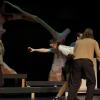August 14, 2000 - 5:00pm
An expectant crowd of marine biologists, fisheries and aquaculture instructors and students are joined by curious onlookers and photographers in the fisheries and aquaculture lab at Malaspina University-College, in Nanaimo.
All eyes are on Gina, a 20-50-year old, 40 kg. 1.7 metre-long Fraser River white sturgeon who will be instrumental in kick starting a new industry in British Columbia - commercial sturgeon farming. Gina's offspring will serve as production and brood stock for Target Marine Products Ltd., of Sechelt, and M & E Enterprises of Port Hardy, who have recently obtained government permits to raise sturgeon commercially.
The sturgeon is a pre-historic fish, virtually unchanged from ancestors dating back 200 million years. Like a shark, it has a skeleton of cartilage, instead of bones, and a thick, armoured skin instead of scales.
"This industry is worth millions in U.S. dollars in California," says Dr. David Lane, a recently retired fisheries and aquaculture instructor at Malaspina, and one of Canada's foremost authorities on sturgeon. Around Malaspina, Lane is affectionately known as 'The Sturgeon General.'
"This is a very good eating fish; I would say it's tastier than salmon, and the caviar from this Fraser River white sturgeon species is extremely good quality," says Lane. "This kind of fish would be raised for a specialty niche market: gourmet dining restaurants. The white sturgeon meat sells at Granville Market in Vancouver for $15 a kilo."
According to Lane, the caviar industry in Russia is all but gone because over-fishing has exhausted the supply and led to skyrocketing prices.
Meanwhile, in Malaspina's aquaculture lab, Gordon Edmondson, nicknamed Malaspina's 'Sturgeon Surgeon,' feels sturgeon Gina's belly to see if it is softening up - a sign that she is getting ready to release her eggs. She was induced on Monday night, but is not ready to spawn until Wednesday morning.
Mr. Joel van Eenennaam, research associate of the University of California at Davis (UCD), has flown in for the occasion to provide his expertise to the operation.
"Joel has spawned more sturgeon that anyone else in North America and knows the latest techniques," says Edmondson. "We're very thankful to the National Research Council and Target Marine Products Ltd. for providing funding for this cooperative venture between Malaspina and UCD."
Van Eenennaam says that UCD has been spawning sturgeons since 1980 and is responsible for the collaborative brood stock development program with commercial sturgeon farmers in California.
Edmondson determines that Gina is getting ready to spawn, and about half a dozen scientists and students spring into action. An anesthetic is added to the water in the tank to keep the sturgeon calm throughout the delicate procedure. Someone does a last minute check to make sure all the instruments are in order: a plastic ladle, scalpel, sample vials, antiseptic cleansers, sutures and six large stainless steel bowls. The "operating table" (a black canvas stretcher) is readied, and Gina is carefully transferred from her tank to the stretcher and covered with wet cloths to keep her comfortable for the one-hour procedure. A water hose is turned on and placed in her mouth; her heart rate is monitored, and she is checked regularly to make sure she is ventilating normally.
With his two middle fingers Edmondson gently applies pressure to the vent on Gina's belly, from which the eggs start to flow into his white ladle. The valuable eggs are quickly transferred into a stainless steel bowl. Once the two ova ducts are emptied out, Edmondson makes a 10 cm cesarean incision in Gina's belly and continues to scoop out her eggs.
The stainless steel bowls with their precious content are quickly transferred into the "wet lab" where the eggs are gently mixed with the sturgeon sperm, collected earlier that morning, for 12 minutes; then fine clay is added to remove the adhesive gel to prevent the eggs from sticking together. One of the scientists gently and very carefully hand-mixes the watery mass for one hour to aid incubation. Next the fertilized eggs are transferred to an incubator where they will hatch in a week; after two weeks the fry will be ¾ inches long and ready to start feeding on their own.
Justin Henry, salmon farmer and manager for Target Marine Products, is watching the whole fertilization procedure with excitement. For him this is the incubation of a brand-new business.
"I would like to see if it's possible to expand into a new species of fish," says Henry. "A lot has been done in California with sturgeon. It's great that Malaspina University-College is doing this kind of research because it's the only site in Canada where we can get sturgeon brood stock since we're not allowed to take it from the wild."
Henry explains that it is next to impossible to import sturgeon broodstock from California. "This allows us to get a start to determine if it's a viable industry," he says.
Henry states that it takes seven to eight years to produce caviar and sturgeon meat commercially.
"It takes a minimum of ten years before you can show a profit," he says.
At the end of the day Lane and Edmondson determine that Gina has released 67,200 eggs, of which 90 to 95% have been successfully fertilized. Henry flies home to Sechelt with 16,000 fertilized eggs and will get 20,000 fry when they hatch.
It has been a successful delivery of thousands of Gina's offspring and marks the birth of a new industry for British Columbia. Gina and the father/scientists are very proud.
Sturgeon Sidebar Information
- The largest fish in the Fraser and Columbia Rivers.
- The sturgeon is a pre-historic fish, virtually unchanged from its ancestors dating back 200 million years.
- The white sturgeon is one of 23 sturgeon species living in fresh and coastal waters in the northern hemisphere, five of which are found in Canada. One of them, the shortnose, is already classified as rare, while the white sturgeon is classed as vulnerable; the others are all acknowledged to be in decline.
- Other types of sturgeon have been bred in Russia and Europe. In the United States, white sturgeon have been hatchery spawned and are presently being commercially raised for meat and caviar in a few farms in California and Idaho.
- It is widely believed that the very large 1,000 pound-and-over specimens have been fished out. In 1897, a white sturgeon was landed in New Westminster weighing 1384 pounds, possibly one of the last of the big fish on the Fraser River.
- Researchers at Malaspina University-College, in Nanaimo, successfully conducted the first-ever captive spawning of the Fraser River white sturgeon, in 1991.
Tags: In the Community






